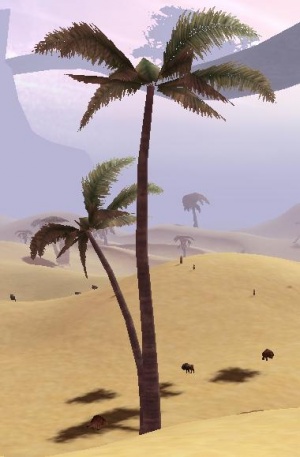From EncyclopAtys
m |
m |
||
| Line 11: | Line 11: | ||
{{MobInfoBox | {{MobInfoBox | ||
|image=desert_olansi.jpg | |image=desert_olansi.jpg | ||
| − | |name= | + | |name={{PAGENAME}} |
|king=Plant | |king=Plant | ||
|species=[[:Category:Stipes|Stipe]] | |species=[[:Category:Stipes|Stipe]] | ||
Revision as of 22:12, 5 September 2019
| Taxonomic Amber | |
| Olansi of the Desert | |
|---|---|

| |
| Kingdom | Plant |
| Category | Stipe |
| Main Ecosystem(s) | Desert |
| Counterattack type | None |
Taller than its cousin of the Lakes, this plant with stem or false-trunk is not a tree. The best botanists believe, in fact, that it is more like a grass.
The foliar crown carried between ten and twenty leaves, sometimes exceeding twenty feet long. The wind of the desert takes away their colour.
A single bud produces all the leaves and flowers. This bud operates continuously: the olansi therefore grows continuously until its death. Although the bud is very well protected, its uniqueness gives the plant a certain fragility, and it is sensitive to the cold. Its presence always signals water in the surroundings.
The olansi produces male and female flowers and therefore can fertilize itself. Its fruit looks like a round nut and contains an edible whitish pulp.
The Fyros extract its oil for multiple uses and employ its shell to craft containers. Its leaves exude a kind of resin and are braided to serve in furniture.Its particular wood has a fibrous grain with two different densities, the hardest part being on the outer perimeter of the trunk.
Like all its cousins it does not produce growth rings as trees do and it therefore shows no knot or other imperfection of any kind. It is used in construction and joinery.
| |
| 25 articles are undergoing translation or proofreading. |




